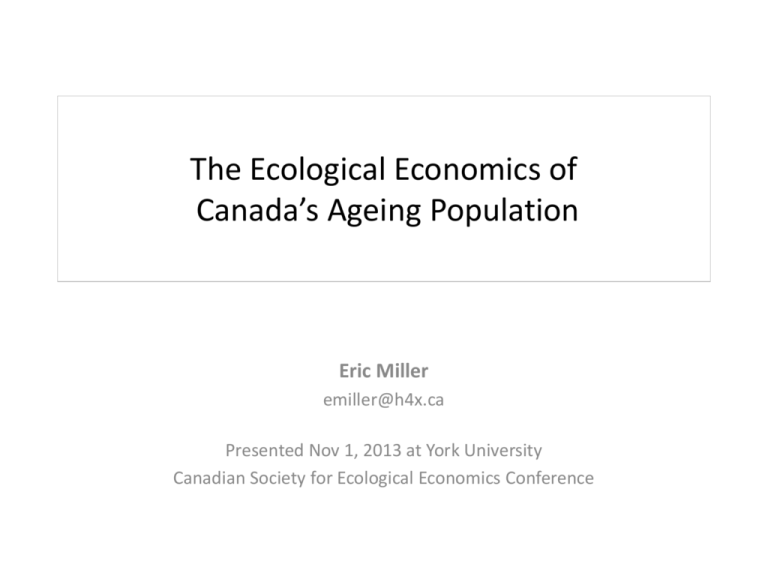The Ecological Economics of Canada's Ageing Population
advertisement

The Ecological Economics of Canada’s Ageing Population Eric Miller emiller@h4x.ca Presented Nov 1, 2013 at York University Canadian Society for Ecological Economics Conference A Conceptual Ecological Economic Demographic Model We should seek to model the means to an efficient, just, and sustainable Canada: • 𝐻𝑎𝑝𝑝𝑦 𝐶𝑎𝑛𝑎𝑑𝑎 = 𝑓𝑛 𝐽𝑢𝑠𝑡𝑖𝑐𝑒 𝑆𝑐𝑎𝑙𝑒 𝑜𝑓 𝑡ℎ𝑟𝑜𝑢𝑔ℎ𝑝𝑢𝑡 𝐸𝑓𝑓𝑖𝑐𝑖𝑒𝑛𝑐𝑦 𝑜𝑓 𝑡ℎ𝑟𝑜𝑢𝑔ℎ𝑝𝑢𝑡 𝑡𝑖𝑚𝑒 ∴ 𝐻𝑎𝑝𝑝𝑦 𝐶𝑎𝑛𝑎𝑑𝑎 = 𝑓𝑛 𝐸𝑥𝑝𝑒𝑟𝑖𝑒𝑛𝑐𝑒𝑑 𝑤𝑒𝑙𝑙𝑏𝑒𝑖𝑛𝑔, 𝐿𝑖𝑓𝑒 𝑒𝑥𝑝𝑒𝑐𝑡𝑎𝑛𝑐𝑦 𝑡𝑖𝑚𝑒 𝐸𝑐𝑜𝑙𝑜𝑔𝑖𝑐𝑎𝑙 𝑓𝑜𝑜𝑡𝑝𝑟𝑖𝑛𝑡 ∴ 𝐻𝑎𝑝𝑝𝑦 𝐶𝑎𝑛𝑎𝑑𝑎 = 𝑓𝑛 𝐿𝑖𝑓𝑒 𝑠𝑎𝑡𝑖𝑠𝑓𝑎𝑐𝑡𝑖𝑜𝑛 × 𝐿𝑖𝑓𝑒 𝑒𝑥𝑝𝑒𝑐𝑡𝑎𝑛𝑐𝑦 𝑃𝑜𝑝𝑢𝑙𝑎𝑡𝑖𝑜𝑛 × 𝐴𝑓𝑓𝑙𝑢𝑒𝑛𝑐𝑒 𝑝𝑒𝑟 𝑐𝑎𝑝𝑖𝑡𝑎 × 𝐸𝐹 𝑜𝑓 𝑎𝑓𝑓𝑙𝑢𝑒𝑛𝑐𝑒 𝑡ime (Inspired by NEF, 2012) Demographics helps to deepen our understanding of life expectancy, the characteristics and size of the population, and demographic patterns of affluence An Empirical Model for Canada Current patterns as model inputs (StatCan, 2012) Average Life Expectancy birth: Lifetime Fertility Rate =at1.678 Total Totalimmigrants emigrants = 52,409 258,290 M = 78.6yrs, F = 82.7yrs Possible futures as assumptions (StatCan, 2010) Population Scenario Lifetime Fertility Gain in Average Life Expectancy at Birth Immigration Rate 1: Low growth Falls to 1.5 Lower (0.6% / yr) Slower than historic trends (15 years slower) 2. Medium growth Stays at 1.7 Current (0.8% / yr) Historic trends (+7M, +5.7F by 2043) 3: High growth Rises to 1.9 Higher (0.9% / yr) Faster than historic trends (7 years earlier) 4: Stabilization Stays at 1.7 Equals migration (0.15%) Historic trends Results of Canadian demographic scenarios Scenarios: 1=Low, 2=Med, 3=High, 4=Stabilization The Hypothesis of Apocalyptic Demography “Today, there are 4.2 working-aged Canadians for every senior citizen, making contributions to cover retirees' pensions and health care. By 2031, that ratio will be cut in half. The tax base will shrink, growth will slow and labour shortages will become even more dire...” Demographic (age-based) dependency Medium growth scenario Labour market dependency Medium growth scenario What about unpaid work? Effects of population growth on dependency __154=Value in 1971___________________________________________ __89=Value in 1971____________________________________________ Growth scenarios: 1 = Low, 2 = Medium based on trend of last 20 years, 3 = High Stabilization: 4 = Medium trend with balanced migration, 5 = Same with “delayed retirement” Understanding the dynamics of Canadian housing • Demographics Household formation & dissolution • Macro-economics Rates of change in household formation • Affluence Demand for number of dwellings, and value • Financial system Cost of financing, risk tolerance of lenders • Expectations of capital gains Willingness to inflate prices • Cohort norms Value of strategic locations Results impact the stock of residential dwellings and market value their land An empirical Canadian housing model Dynamics of residential land value 1=Actual total Res Capital Stock 2=Actual Res structures Modelled values: 4=Predicted Res structures $M CAD 3=Actual Res land 5=Predicted Res land Dynamics of investment in residential structures 1=Actual rate of gross investment in Res Capital Stock 2=Modelled rate (of #1) 3=Modelled rate of invest from renovations to existing structures; 4=Other 5=Modelled rate of investment from new structures Annual Rate Speculating about future housing dynamics (all scenarios assume 2010 patterns of household headship rates) Growth scenarios: 1 = Low, 2 = Medium based on trend of last 20 years, 3 = High Stabilization: 4 = Medium trend with balanced migration, 5 = Same with “delayed retirement” Concluding messages • Demographics should play an important role in EE • Beware of apocalyptic demography in Canada as a new rationale for austerity and growth for the sake of growth • Systems dynamics modelling useful for modelling residential housing market (structures and land value) • Understanding housing will help to understand an important component of life satisfaction during working years and into retirement, and the future ecological implications of growth in households, dwellings per household, and value per dwelling References cited • Globe and Mail. 2012. The great expansion. Saturday May 4. Section F. • New Economics Foundation. 2012. Happy Planet Index: 2012 Report. A global index of sustainable well-being. All other Statistics Canada data is from CANSIM

